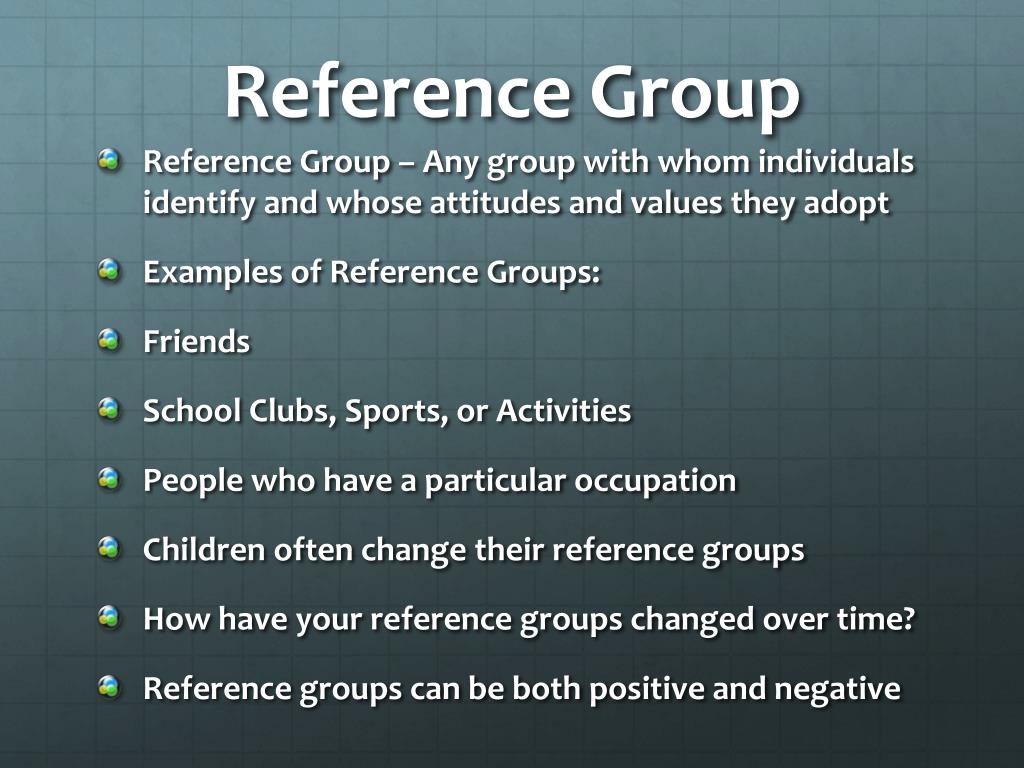Imagine walking into a new school, a vibrant social scene buzzing with energy and, frankly, a touch of intimidation. Suddenly, you spot a group of students known for their artistic talent. Their laughter, their shared passion, their effortless coolness – you find yourself drawn to them, yearning to be part of their world. Welcome to the fascinating realm of reference groups. This is where our social identities are shaped, our aspirations take flight, and our understanding of ourselves is challenged and redefined.

Image: www.slideserve.com
Reference groups, in the eyes of sociology, are the social networks we compare ourselves to, the individuals and groups whose values, attitudes, and behaviors profoundly influence our own. These groups, in all their diversity, play a crucial role in shaping our sense of self, guiding our decisions, and ultimately influencing the trajectory of our lives.
Diving into the World of Reference Groups
The concept of reference groups was first articulated by sociologist Herbert Hyman in the 1940s. He observed that individuals, especially adolescents, tend to base their behavior and aspirations on groups they admire, even if they don’t directly belong to them. This “reference” serves as a framework for understanding social norms, setting standards, and defining our place within the broader social landscape.
Types of Reference Groups
Reference groups can be broadly categorized into:
- Membership groups: These are the groups we actively belong to and identify with, such as our family, friends, religious communities, professional organizations, or sports teams. These groups often have a strong, direct influence on our values and behaviors.
- Aspirational groups: These groups are those we admire and aspire to be a part of, often because of their social status, achievements, or values. They might be celebrities, successful entrepreneurs, or communities known for their dedication to a particular cause. Aspirational reference groups can inspire us to strive for excellence, pushing us to achieve our goals.
- Disassociative groups: These are the groups we actively reject and distance ourselves from, often due to opposing values, beliefs, or behaviors. Disassociative groups can serve as a strong motivator for individuals to cultivate their own unique identities and embrace their personal values.
The Power of Influence: How Reference Groups Shape Us
The impact of reference groups on our lives is multifaceted and dynamic. Here are some key ways they influence us:
1. Shaping Values and Beliefs: Reference groups provide a social framework for understanding what is right and wrong, desirable and undesirable. These groups play a significant role in shaping our ethical compass, our perception of social norms, and our understanding of the world around us.
2. Defining Our Identity: By comparing ourselves to reference groups, we gain insights into our own strengths, weaknesses, and unique qualities. These comparisons help us understand how we fit into the social landscape and guide our efforts to develop and refine our own identities.
3. Motivating Behavior: Reference groups often serve as benchmarks for our aspirations and goals. They provide us with role models to emulate, a framework for setting ambitions, and a source of motivation to strive for personal and professional growth.
4. Driving Consumerism: The influence of reference groups is particularly evident in the realm of consumerism. Ads cleverly target our aspirational groups, tapping into our desire for social acceptance and status. Products and brands are often associated with particular reference groups, shaping our buying habits and influencing our preferences.

Image: thegeneralfacts.com
Examples of Reference Groups in Action
To understand the power of reference groups, let’s explore some real-world examples:
- Teenage Fashion: A young teenager might follow the fashion trends of their peer group, adopting styles and brands they see as cool and socially desirable. Their classmates, their idols, and the media all contribute to this aspirational reference group.
- Career Aspirations: A college student might look up to successful entrepreneurs or doctors, aspiring to achieve similar levels of success. They might emulate their work ethic, study habits, and values, striving to emulate their path.
- Social Activism: Individuals might find themselves inspired by a charismatic activist or social movement, joining their cause and aligning their values with those of this reference group. Their commitment to this cause becomes a defining part of their identity.
Positive and Negative Aspects of Reference Groups
While reference groups play a vital role in shaping our social lives, their influence is not always positive.
Positive Aspects:
- Socialization and belonging: Reference groups provide a sense of community, belonging, and acceptance, fostering social cohesion and reducing feelings of isolation.
- Motivation and inspiration: These groups can serve as a powerful source of motivation, inspiring individuals to strive for personal and professional growth, achieve goals, and make positive contributions to society.
Negative Aspects:
- Conformism and peer pressure: While we gain a sense of belonging, reference groups can also lead to conformity and pressure to conform to established norms, leading to a suppression of individuality.
- Social comparison and dissatisfaction: Constant comparison with reference groups can fuel feelings of inadequacy, dissatisfaction, and envy, hindering personal growth and well-being.
Harnessing the Power of Reference Groups
Understanding the influence of reference groups is more than just a sociological exercise; it’s a powerful tool for personal development and navigating a complex social world. Here are some key takeaways to help you leverage the power of reference groups:
- Be mindful of your influences: Recognize the groups that shape your values and beliefs, and assess their impact on your life.
- Embrace healthy competition: Use reference groups as a source of inspiration, not envy. Their successes can motivate you to strive for your own goals.
- Develop your own identity: Avoid blindly conforming to external pressures. Embrace your individuality and cultivate your own set of values and beliefs.
Examples Of Reference Groups Sociology
Conclusion: Embracing the Social Landscape
Reference groups are an integral part of the social tapestry, weaving together shared values, driving our aspirations, and shaping our identities. By recognizing their influence, both positive and negative, we can harness their power to navigate our own paths, embrace our individuality, and contribute meaningfully to the social fabric of our communities.






